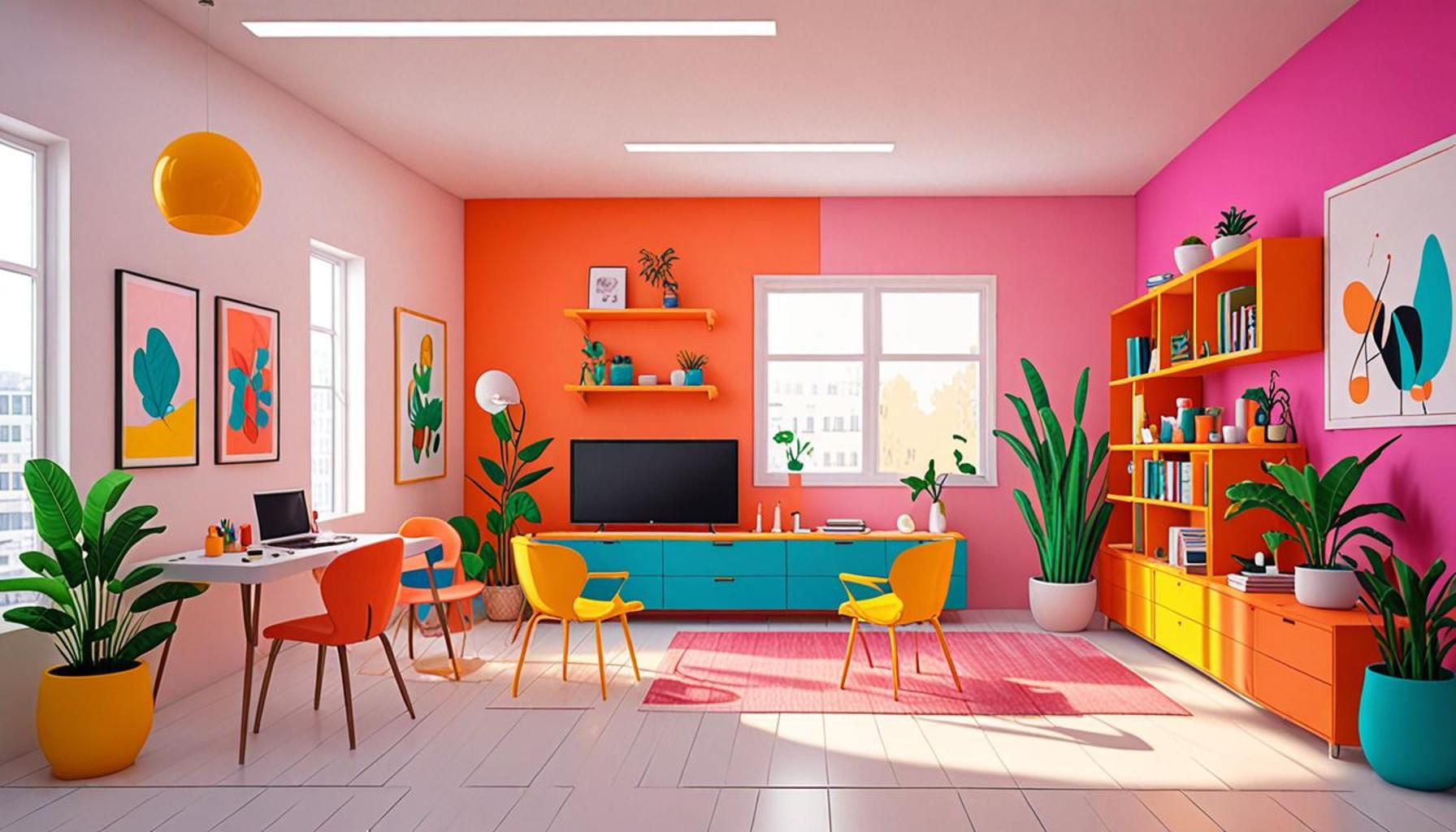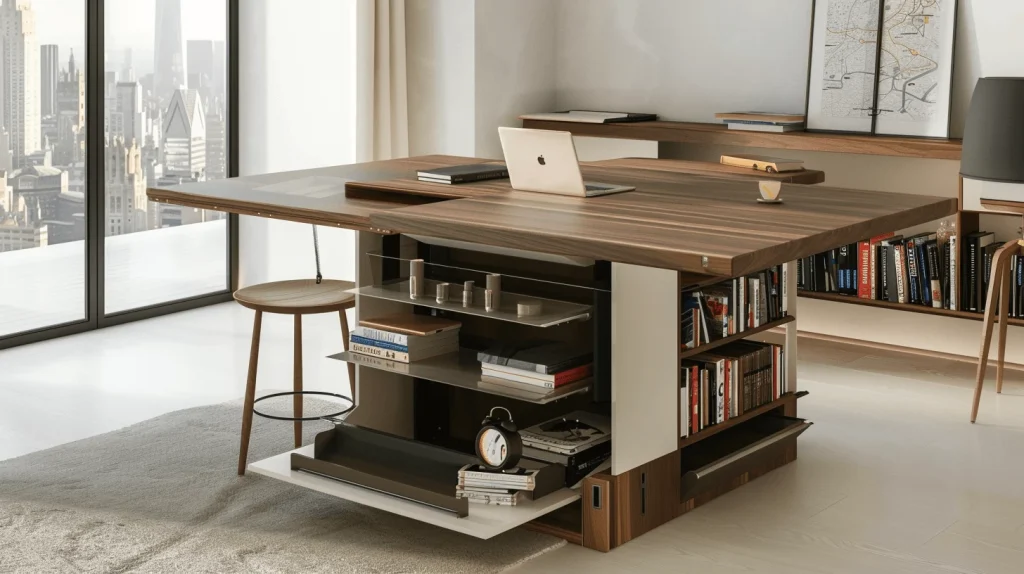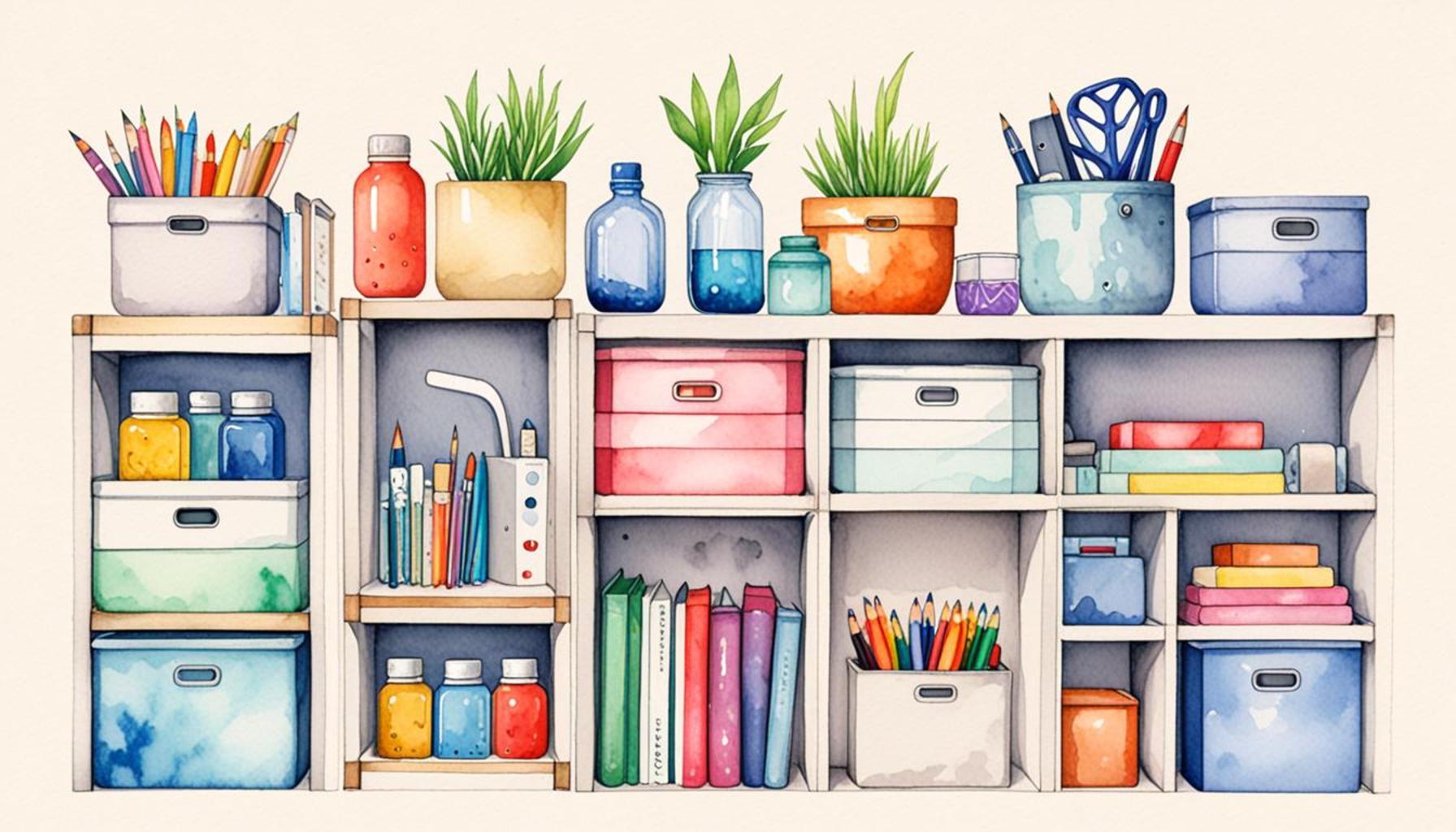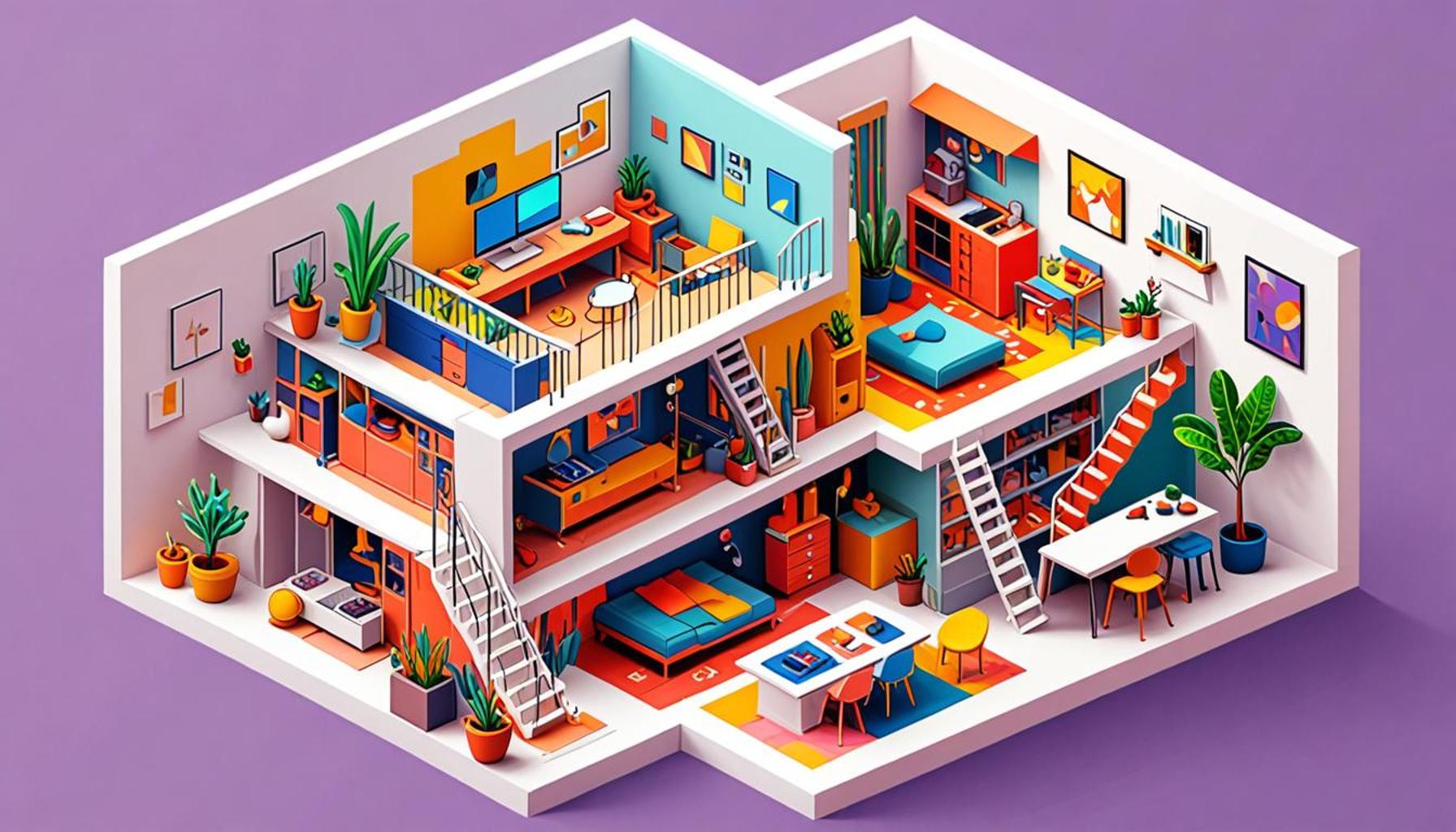Multifunctional Spaces: How to Design Environments that Serve Multiple Functions in Minimalist Style

Embracing Versatility in Design
In an age where space is a luxury, multifunctional spaces emerge as a necessity, especially within urban settings. These environments blend practicality with aesthetic appeal, catering to various needs without sacrificing style. Discover how minimalist design principles can enhance these versatile areas.
The Appeal of Multifunctional Spaces
Designing spaces that serve multiple functions allows for:
- Increased Efficiency: Multifunctional designs enable seamless transitions between activities, such as transforming a living room into a workspace for remote work or even a yoga studio. This adaptability saves time and maximizes productivity.
- Simplified Clutter Management: In a multifunctional environment, fewer items are required to achieve the desired tasks, leading to less visual noise. For example, using a wall-mounted desk that folds away when not in use can significantly reduce clutter in a smaller apartment.
- Enhanced Flexibility: As lifestyles and family dynamics change, so too must our living environments. Multifunctional spaces can easily adapt to host gatherings, provide a peaceful retreat for reading, or even accommodate guests, enhancing their overall usability.
Furthermore, minimalism focuses on essential elements, encouraging a clean and functional design. This approach is not only stylish but also practical, making it easier to maintain a cohesive look. By decluttering our spaces of unnecessary items, we create room for creativity and tranquility, allowing the remaining elements to breathe and stand out.
Examples of Multifunctional Spaces
The concept of multifunctionality can manifest in various forms, showcasing its adaptability across different environments:
- Convertible Furniture: A prime example is a sofa that becomes a bed for overnight guests or a dining table that can expand to accommodate more people during gatherings. These innovative furniture pieces are not only space-saving but also lend a modern touch to interiors.
- Open Layouts: An open-concept living space invites fluid movement and provides the opportunity for multiple usages, such as cooking while entertaining guests. These layouts eliminate barriers, creating a more inviting atmosphere conducive to both socializing and relaxation.
- Integrated Technology: Smart home technologies can enhance functionality by enabling control over lighting, temperature, and security purposes, catering to diverse needs effortlessly. For instance, programmable lighting can change according to activities – brightening for work or dimming for a movie night.
As you explore how to create these innovative spaces, you will find that minimalist design is not just a trend but a philosophy offering myriad possibilities for modern living. Embracing versatility in design ultimately leads to a more fulfilling, organized, and harmonious lifestyle. By making intentional choices about our environments, we embrace efficiency and style, showing that less can indeed be more.

EXPLORE MORE: Click here to discover the psychological benefits of conscious consumption
Designing with Purpose and Intent
Creating multifunctional spaces requires foresight, creativity, and an understanding of how individuals utilize their environments. Within the principles of minimalist design, these elements can seamlessly coexist to craft areas that not only look appealing but also cater to a plethora of activities. To effectively achieve this balance, one must consider a few key strategies that prioritize purpose and functionality.
Emphasizing Functionality in Design
The underlying principle of minimalist design is to focus on essential functions while eliminating the superfluous. To create a multifunctional space, it is vital to critically assess how each element serves the overall purpose. Here are several strategies to enhance functionality:
- Multifunctional Furniture: Invest in pieces that adjust to various tasks. For instance, a coffee table with storage space can double as both a stylish centerpiece and a functional space to keep essentials organized. Look for ottomans that open up, providing extra seating while housing blankets or magazines.
- Dedicated Zones: Use furniture arrangements, rugs, or movable screens to delineate areas within a single room. For example, place a small desk in a corner to form a workspace within a living area. This allows individuals to switch seamlessly between relaxation and productivity without the need for large, separate spaces.
- Smart Design Choices: Incorporate designs that adapt to different needs such as wall-mounted shelves that can be adjusted or repositioned based on current storage requirements. This level of adaptability helps in maintaining a minimalist aesthetic while ensuring that the environment remains functional.
Utilizing Natural Light and Color Schemes
Natural light is a powerful tool in multifunctional spaces. It not only enhances the aesthetic appeal but also contributes significantly to the well-being of inhabitants. Maximizing the flow of natural light can be achieved by:
- Strategically Placed Windows: Design with oversized windows or transparent doors that open to outdoor spaces. This not only creates an illusion of larger areas but connects the indoors and outdoors, offering versatility.
- Light-Reflecting Surfaces: Utilize mirrors and light-colored walls to bounce light around the space. These elements generate a bright and airy environment, making a room feel less cramped while encouraging a sense of openness.
Choosing a neutral color palette is another hallmark of minimalist design. Shades of white, beige, and gray evoke tranquility and cohesiveness while allowing for easy integration of decor items. Accent pieces can introduce personality and charm without overwhelming the space, offering a perfect balance between minimalism and individuality.
As the demand for versatile living environments continues to grow, understanding and applying these minimalist principles can transform ordinary spaces into havens of multifunctionality. Exploring innovative design options not only enhances how we interact with our homes but also aligns with a lifestyle that champions mindful living and efficiency.
As our living and working environments evolve, the concept of multifunctional spaces becomes increasingly relevant. These spaces not only maximize utility but also bring a sense of harmony and simplicity through minimalist design. By thoughtfully integrating multiple functions into a single area, one can create an atmosphere conducive to both productivity and relaxation.
One essential strategy in designing multifunctional spaces is to use flexible furniture. Pieces that can serve multiple purposes—like sofas that convert into beds or tables that can expand and contract—allow for adaptability in various settings. Such solutions not only save space but also reduce clutter, ensuring that the environment remains visually appealing while serving its diverse functions.
Another crucial aspect is the use of zoning techniques. By defining different areas within a single room—through the use of rugs, lighting, or partitions—one can visually segment activities. For instance, a single room can accommodate a home office, a cozy reading nook, and a dining area by strategically using these zoning techniques. This approach also encourages a seamless transition between tasks, which can enhance overall efficiency.
Natural light plays a pivotal role in enhancing multifunctional space design. Large windows or open layouts allow for an abundance of sunlight, creating a welcoming environment that can elevate mood and productivity. Incorporating elements such as indoor plants can further add to the aesthetics while purifying the air, promoting a sense of tranquility in a multifunctional area.
By embracing these innovative design principles, individuals and designers alike can forge unique spaces that not only meet diverse needs but also embody the essence of minimalist style. This combination holds the potential to transform standard environments into powerful, multifunctional hubs that inspire both creativity and balance.
| Category | Description |
|---|---|
| Flexible Furniture | Furniture that adapts to different uses, such as convertible sofas, offers versatility in design. |
| Zoning Techniques | Using areas effectively through rugs and lighting to create distinct zones for different activities, enhancing organization. |
| Natural Light | Incorporating ample light improves mood and efficiency while contributing to a fresh and open ambiance. |
The careful design of multifunctional spaces through these principles leads to environments that are not only efficient but also reflect a minimalist philosophy, providing comfort and style in a clutter-free setting.
DISCOVER MORE: Click here to learn about mindful consumption
Integrating Technology for Enhanced Functionality
In an increasingly digital world, the integration of technology into multifunctional spaces plays a crucial role in optimizing functionality. Utilizing smart technology can revolutionize how spaces are used and enhance the minimalist lifestyle by keeping clutter to a minimum. Here are some thought-provoking ways to incorporate technology effectively:
- Smart Home Devices: From voice-activated assistants to smart thermostats, technology can simplify daily tasks and enhance the user experience. For instance, smart lighting can adjust based on the time of day or tasks at hand, transitioning to brighter settings for work and softer hues for relaxation. By integrating these devices, homeowners can maintain control and flexibility without the need for numerous physical switches and controls.
- Multi-Use Media Centers: Designing a space for entertainment often requires a balance between aesthetics and functionality. A media center that organizes electronics and integrates streaming technology can create an engaging area for relaxation or gatherings without overcrowding the living space. Embedded speakers and flush-mounted screens contribute to a refined look while still providing high-quality entertainment.
- Modular Tech Solutions: With advancements in technology, modular solutions that can adapt to various settings are becoming increasingly popular. For example, foldable screens can create an office in a living room or a temporary guest room, allowing individuals to transform their environments based on need without permanent alterations.
Collaborating with Nature: Indoor-Outdoor Flow
The relationship between our interiors and the outdoors can significantly influence multifunctional space design. Making use of natural elements contributes not only to the aesthetics of a minimalist environment but also enhances the sense of space and purpose:
- Outdoor Extensions: Consider creating seamless transitions between indoor and outdoor spaces. Features such as sliding glass doors or foldable walls can open living areas to patios or gardens, effectively expanding the functionality of the home. This provides opportunities for outdoor dining, relaxation, or recreational activities, all within one cohesive design.
- Incorporating Greenery: Plants not only add beauty but also help purify the air and create a soothing ambiance. Vertical gardens and planter boxes can redefine walls or surfaces, contributing to the aesthetic while serving as natural dividers between different functional areas. This approach nurtures a sense of well-being and encourages inhabitants to spend time in their multifunctional spaces.
Storage Solutions: Practicality Meets Aesthetics
A minimalist design thrives on simplicity, and effective storage solutions are essential in achieving this objective. To enhance the functionality of spaces while maintaining an uncluttered look, consider the following:
- Built-In Storage: Customized built-in cabinetry not only saves space but can also be designed to fit into architectural niches, thereby maximizing utility. Combining shelving with hidden closets enables homeowners to store items out of sight, while still being easily accessible when needed.
- Decorative Storage Baskets: When open storage is necessary, using decorative baskets or boxes can add to the design aesthetic while discreetly organizing essentials. This simple yet effective approach keeps items contained and contributes to the overall visual appeal of the space.
By integrating technology, embracing natural elements, and implementing practical storage solutions, designers and homeowners can create multifunctional spaces that not only embody the essence of minimalist style but also promote versatility, comfort, and efficiency in daily living. As these concepts continue to evolve, the possibilities for innovative design will undoubtedly expand, inviting exploration and imagination.
DIVE DEEPER: Click here to discover the benefits of minimalism
Conclusion: Embracing the Future of Living in Multifunctional Spaces
As we navigate an ever-evolving world, the concept of multifunctional spaces emerges as a transformative solution to modern living challenges. The minimalist style, characterized by its focus on simplicity and functionality, provides an ideal framework for designing environments that serve multiple purposes without compromising aesthetics. By thoughtfully integrating technology, blending indoor and outdoor elements, and implementing innovative storage solutions, individuals can create versatile spaces that cater to their diverse needs.
Consider the impact of seamless transitions between indoor and outdoor areas, which not only expand functional living space but also enrich our connection with nature—an essential aspect of modern well-being. Adopting smart devices that enhance everyday life while minimizing clutter demonstrates how technology can fit harmoniously into our minimalist aspirations. Additionally, the art of combining functionality with design through built-in and decorative storage must not be overlooked, as it plays a pivotal role in maintaining an airy, organized feel.
Ultimately, the journey toward designing multifunctional spaces opens doors to creativity, allowing homeowners to embrace indeed a fluid lifestyle that reflects their identities. As we evolve in our living environments, the principles of minimalist design serve as guiding stars, fostering balance, efficiency, and comfort. This exploration invites readers to reflect on their spaces and to consider how they can make adjustments that not only meet their needs but also enrich their day-to-day experiences.


